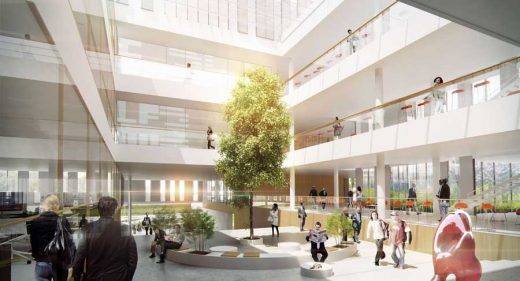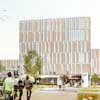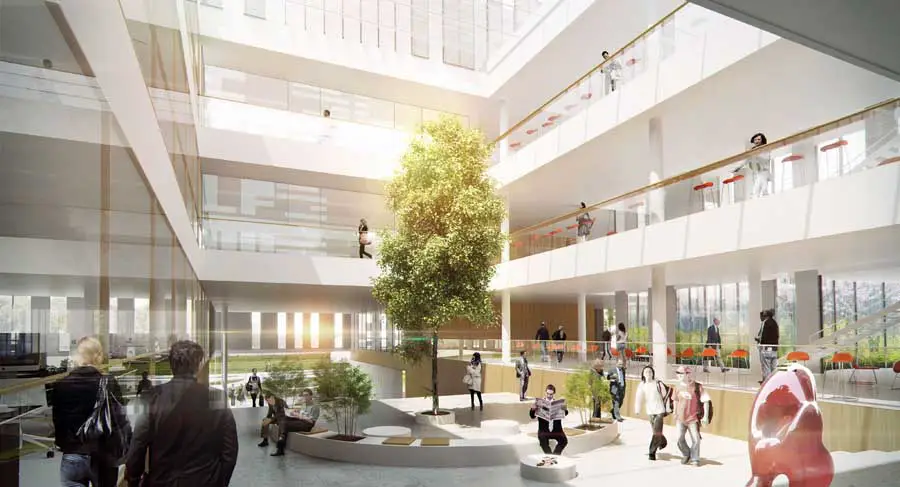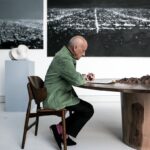Center for Solar Energy and Hydrogen Research in Stuttgart, Renewable Energy Building Germany
Center for Solar Energy and Hydrogen Research Stuttgart
ZSW Renewable Energy Building Stuttgart, Germany design by Henning Larsen Architects
13 Oct 2012
Center for Solar Energy and Hydrogen Research in Stuttgart
Center for Solar Energy and Hydrogen Research, Stuttgart
Design: Henning Larsen Architects
New German project won by Henning Larsen Architects
Henning Larsen Architects has won the competition for a new research building for the Center for Solar Energy and Hydrogen Research in Stuttgart. The Center is one of Germany’s leading research institutions and conducts research on renewable energy.

picture : Christian Schjøll / Wesam Asali
The new research building in Stuttgart is designed as a grid of small units to meet the requirement for a highly flexible workplace that serves as a dynamic framework for the ongoing research and innovation activities of the centre.
“The grid structure of the research centre ensures a high degree of mobility and freedom to change and expand the building”, explains Design Director Louis Becker, Henning Larsen Architects. “The building has a rational design and is organised in modules. This creates visual contact across the atriums and green oases, which the researchers can use for work or informal meetings.”
Carefully integrated into the surrounding context, the building features various heights that relate to the city and adjacent buildings. The building will create a new, distinctive entrance to Stuttgarter Engineering Park and provide an insight into the ongoing research.

picture : Christian Schjøll / Wesam Asali
”We look very much forward to the collaboration. The researchers of the centre hold a world-leading position in their field, sustainable technology and energy forms. The research has been integrated into the facade design”, says Werner Frosch, General Manager of Henning Larsen Architects Munich.
In Munich, Henning Larsen Architects also works on the design of Siemens’ new global headquarters that has a central location in Munich. Both buildings are good examples of how architecture creates added value by providing the employees with a bright, flexible workplace. Another common feature of the two projects is their way of giving something back to the city and surrounding space. The Center for Solar Energy and Hydrogen Research covers 13,000 m2 and is expected to be completed in 2016.
Since opening an office in Munich in 2011, Henning Larsen Architects has gained a strong foothold in the German market. Today, the Munich office employs 25 people.
The new Center for Solar Energy and Hydrogen Research situated in Stuttgarter Engineering Park (STEP) will house researchers conducting research on sustainable technologies and energy forms. The flexible building design allows for it to be adapted to new, changed research requirements in the future.
Carefully integrated into the surrounding context, the building features various heights that relate to the city and adjacent buildings. The building will create a new, distinctive entrance to Stuttgarter Engineering Park and provide an insight into the ongoing research. It has been a specific wish of the researchers that their work is reflected in the facade design.
The Center for Solar Energy and Hydrogen Research comprises offices, laboratories, meeting and conference facilities. It is designed as a grid of small units to meet the requirement for a highly flexible workplace that serves as a dynamic framework for the ongoing research and innovation activities.
The individual spaces can easily be connected to create larger spaces as needed. The different units are made up of modules – with a large, open courtyard or atrium in the middle of every module. This structure accentuates the spatial qualities and facilitates the users’ orientation in the building. The atriums bring daylight far into the building and function as natural gathering points during the workday.
The grid structure ensures a high degree of mobility and freedom to change and expand the building. The organisation in modules allows for small expansions over time, as little as 300 m2 at a time if required. In addition, the rational building design creates visual contact across the atriums and green oases, which the researchers can use for work or informal meetings.
The scale of the building adapts to the local context, which accommodates both families and large research institutions. The various heights of the modules thus also represent the diversity of research activities and departments at the Center for Solar Energy and Hydrogen Research.
Sustainability
The Center for Solar Energy and Hydrogen Research Baden-Württemberg meets strict, German requirements for sustainability. Through the design process, the energy consumption of the building has continually been simulated through studies of volume, material selection, ceiling height, light and shadow, sound, wind and opportunity for indoor and outdoor spaces. By selecting and fully exploiting the most efficient solutions, the energy consumption of the centre has been minimised. Particularly, an effective use of daylight has contributed to reducing the energy consumption.
About Center for Solar Energy and Hydrogen Research
The Center for Solar Energy and Hydrogen Research Baden-Württemberg (ZSW) in Stuttgart is one of Germany’s leading research institutions and conducts research on renewable energy. The centre employs a staff of more than 220 researchers, engineers and technicians who are distributed across several offices in Germany, more specifically inStuttgart, Ulm and Widderstall.
Center for Solar Energy and Hydrogen Research in Stuttgart – Building Information
Project Name: Center for Solar Energy and Hydrogen Research in Stuttgart
Location: Stuttgart
Client: ZSW Zentrum für Sonnenenergie und Wasserstoff-Forschung Baden-Württemberg
Architect: Henning Larsen Architects
Gross floor area: 13,000 m2
Type of assignment: 1st prize in invited, international competition
Team: Henning Larsen Architects, Transsolar, Knippers Helbig and ZWP Ingenieur AG
Team at Henning Larsen Architects: Louis Becker (Partner), Werner Frosch (Project Director), Kostas Poulopoulos (Lead Design Architect), Ósbjørn Jacobsen, Andreas Schulte, Maine Godderidge, Silke Jörgenshaus, Blanca Ulzurrun, Emil Skibsted Tranæs, Laura Schmitt and Julia Menz
Sustainability concept: Signe Kongebro, Jakob Strømann-Andersen, Lise Mansfeldt Faurbjerg and Kalle Park
Illustrations: Christian Schjøll and Wesam Asali
Center for Solar Energy and Hydrogen Research in Stuttgart images / information from Henning Larsen Architects
Henning Larsen Architects
Location: Winnenden, Stuttgart, Germany
Architecture in Stuttgart
Stuttgart Architecture Designs – chronological list
Architecture Walking Tours by e-architect
Stuttgart Buildings
Mercedes-Benz Museum
UN Studio Architects
Mercedes Museum Stuttgart
Porsche Museum
Delugan Meissl
Porsche Museum Stuttgart
Neue Staatsgalerie
Jim Stirling & Partner; Jim Stirling Michael Wilford & Associates
Neue Staatsgalerie Stuttgart
Killesberg Urban Quarter
various Architects
Killesberg Urban Quarter ‘Zukunft Killesberg – Think k’
Comments / photos for the Center for Solar Energy and Hydrogen Research – Stuttgart Building page welcome



